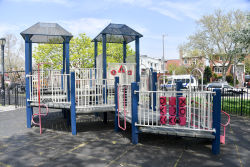Dyker Beach Park
Anthony Mosomillo Memorial Courts
The Anthony Mosomillo Courts, located within Dyker Beach Park at Bay Eighth Street and Cropsey Avenue, are named for Police Officer Anthony Mosomillo (1962-1998), who was killed in the line of duty while attempting to execute a bench warrant in the 67th Precinct. Months after his death, a local law renamed this parkland from the Bay Eighth Street Ballfields to Anthony Mosomillo Memorial Courts to honor the fallen officer. Mosomillo was a proud native of Bensonhurst and was dedicated to his community. He attended Lafayette High School and served in the New York Police Department for more than 14 years in the 60th and 67th Precincts in Brooklyn. Even after moving his family to Queens, he often returned to the neighborhood to play handball and basketball at these courts. A Medal of Honor was given to Mosomillo’s family in his name a few months before the renaming of the courts. Officer Mosomillo is survived by his wife Margaret, daughters Maria and Francesca, parents Anthony Sr. and Marie, brother Sal and two sisters, Mary and Debbie.
As early as 1639 Dutch settlers bought land from the Canarsee Indians in the neighborhood now known as Dyker Heights. By 1657 the area was annexed as part of New Utrecht, one of the six original Dutch towns that later joined to form the City (now borough) of Brooklyn. Waves of immigrants made their homes here – in the 19th century from Scandinavia, from Ireland and Italy in the early 20th century, and from China, Italy, and the former Soviet Union in more recent years.
The area was not developed as a residential neighborhood until the early 20th century, at which time it took its name, Dyker Heights. Block after block of one- and two-family houses were constructed, and land developers named the area after nearby Dyker Park and Dyker Beach. There are two differing stories concerning how these Brooklyn places got their names. The namesake may have been the Van Dykes who helped to divide the land when it was part of the Dutch town of New Utrecht. Alternatively, the name may reflect the dikes that the Dutch settlers used to drain and reclaim the marshy land.
The park was assembled from eight pieces of land over the course of forty years. In 1895 the City of Brooklyn purchased the first parcel from the Dyker Meadow Land Improvement Company for a park. The landscape architecture firm of Olmsted, Olmsted & Eliot - an incarnation of the firm first founded by Frederick Law Olmsted (1822-1903), with his stepson (and onetime nephew), John Charles Olmsted, as partner - planned a 50-acre saltwater lagoon, children’s playgrounds, bathhouses, lawns, and drives along the shore. Though the famous architect of Central Park did not participate in its design—1895 was the year his deteriorating mental condition forced him into a sanitarium—the 1896 Annual Report of the Brooklyn Parks Department claimed that Dyker Beach would be the “finest seaside park in the world.”
Although a portion of the site was used by the Dyker Meadow Golf Club, development of the remainder proceeded slowly. Bathhouses and roads were erected, and the plans were revised somewhat in 1911 by Charles D. Lay, former landscape architect of the Park Board. He proposed to decrease the size of the lagoon to 16 acres and add several concert groves. In 1918 work began to fill a swampy area of the park. Four additional parcels were acquired between 1924 and 1927 by assignment and condemnation. Another three lots were transferred to Parks in 1934.
Check out your park's Vital Signs
Clean & Safe
Green & Resilient
Empowered & Engaged Users
Share your feedback or learn more about how this park is part of a
Vital Park System










